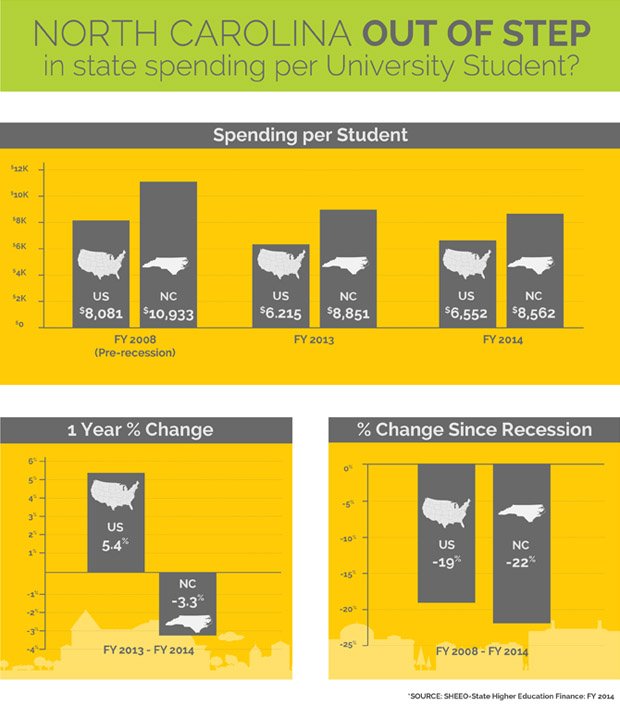The Great Recession required sacrifices across the country. Households cut spending, state governments trimmed their budgets, and public universities in almost every state saw significant cuts.
North Carolina was no exception. Starting in 2008, lawmakers pulled back on higher education spending, forcing students and families to cover more of the cost through tuition and fees.
North Carolina’s public universities still receive more state support than their counterparts in every state but Wyoming, Alaska and Illinois.[1] But now, as almost every state in the country reinvests in public universities, North Carolina is the exception.
Where state support once distinguished North Carolina at $10,933 per student in FY 2008, we spent $8,562 per student in FY 2014.[2]
According to data recently released by the State Higher Education Executive Officers Association, North Carolina lawmakers cut per-student spending another 3.3% last year, even as the economy grew at a solid pace.[3] North Carolina’s population and economy are expanding,[4] but public university funding is not. Even as the rest of the country boosted per-student spending an average of 5.4% in FY 2014, North Carolina’s investment in higher education continued to contract.
Since the start of the Great Recession, per-student funding for North Carolina’s public universities is down by almost 22%.[5] While university funding remains higher than in many states, repeated cuts since 2008 have put financial stress on students and families, and threatened the North Carolina’s hard-earned position as a leader in public higher education.
“Education, and our ability to support it, is under intense pressure,” said State Sen. Jeff Tarte (R-Mecklenburg), speaking at a forum organized last month by Higher Education Works and the Harvard Club of the Research Triangle.[6]
Other states have found a way to bolster their colleges and universities in the aftermath of the recession. Tennessee, under Republican Gov. Bill Haslam, boosted higher education spending by 11% last year.
“The reason we continue to make these investments in education is we want Tennesseans to have the education, training and skills necessary to have a good-paying, high-quality job,” Haslam said in his State of the State address this year. “There is nothing more important to our state than getting education right.”[7]
North Carolina lawmakers have also praised the role of higher education in building a strong, competitive workforce. Tarte called colleges and universities “the single most important asset in the entire state of North Carolina.”
But that hasn’t been reflected in the state budget, which continued to neglect some of the state’s most valuable institutions in 2014. What will state legislators do to invest in our public universities in 2015-16?
[1] State Higher Education Executive Officers Association. 2014. Table 5, p. 32. http://www.sheeo.org/sites/default/files/project-files/SHEF%20FY%202014-20150410.pdf
[4] North Carolina Economic Outlook: February 2015. Wells Fargo Securities. https://www08.wellsfargomedia.com/downloads/pdf/com/insights/economics/regional-reports/NC_Economic_Outlook_02122015.pdf
[5] State Higher Education Executive Officers Association, op cit.
[6] http://www.higheredworks.org/blog/legislators-college-leaders-warn-of-challenges-for-nc-higher-education
[7] “Haslam budget invests heavily in higher ed.” The Tennessean. February 10, 2015. http://www.tennessean.com/story/news/education/2015/02/09/haslambudgetinvestsheavilyhighered/23153223


Leave a Reply